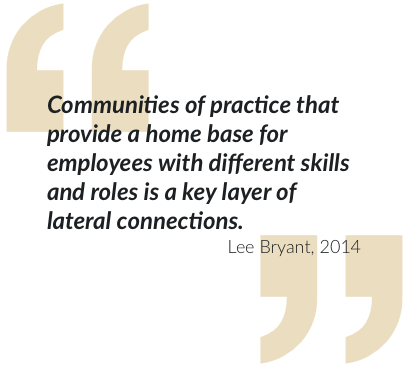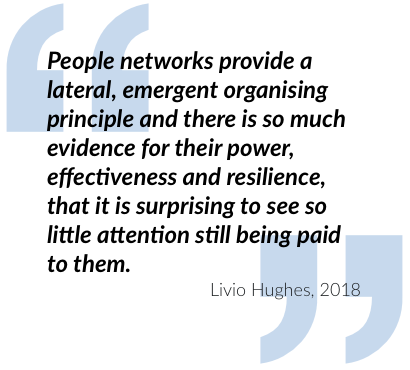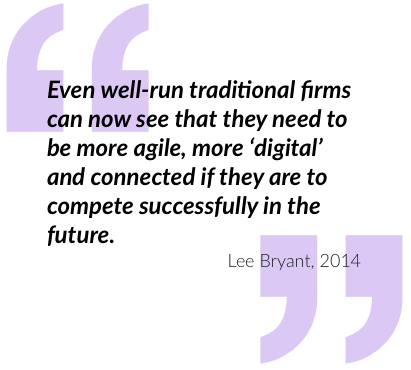Org Structure
Digital Workplace Futures
Many of us who were involved in the early days of introducing social software to organisations did so with the goal of reducing bureaucracy and humanising the enterprise.
As the use of tools has matured, we have seen new types of structures emerge and flourish. The most successful early use cases centred on communities of practice as a way to more effectively share information. Networks emerged as a way to co-ordinate work across boundaries. Agile teams appeared at the edges of the organisation, allowing more temporary structures to appear, achieve a goal and then be disbanded.
Unlike other shifts we have documented, none of these structures have disappeared – they are all present in adaptive organisations that are prepared for the challenges of the digital age. But the challenge of moving beyond simple cascading hierarchy as a way to coordinate work remains a tough one, with lots of ingrained habits and systems that need to be re-worked.
Large organisation looking for a radical org structure transformation are inspired by the connected company models of Amazon and Haier – those who have truly embraced the organisation-as-a-platform paradigm.
> Introduction
> Technology
> Ownership
> Community
> Design
> Collaboration
> Skills
> Change Agents
> Leadership
> Org Structure
> Measurement
> Conclusion
- SHIFT 1: Communities of Practice
- SHIFT 2: Networks
- SHIFT 3: Agile Teams
- NEXT: Organisation-as-a-Platform
- SHIFT 1: Communities of Practice
Organisations that experimented early with collaboration tools focused on building tightly-linked communities of practice, aligned to practical processes. Their simple design enabled radical levels of knowledge sharing and learning. They were a natural evolution of the formal knowledge management (KM) systems built in the 1990’s, and in fact delivered on their promises more effectively than previous efforts.
These communities were made up of committed, curious employees who were interested in the benefits of this new technology, willing to experiment and try simple solutions as an iterative process. Ever since, communities have gone from strength to strength and are a key way an organisation can deliver new value. Most high-value communities are overseen by a community manager, who provides strategy and tactics for working smarter, as well as ensuring that measurement approaches are embedded to share success stories.
- SHIFT 2: Networks
Networks were initially seen as being of both personal and local interest, but focused mostly on networking outside the organisation. Networks are a great structure for dealing with complex, multi-disciplinary topics that require a vast array of expertise to solve. Since networks are made up of a collection of weak and strong ties, they form a dynamic structure that is perfect for co-creating value, innovating and learning.
As the digital workplace evolved, individuals started to use two types of global networks – one more formal type of network with shared goals and another as a sensor network for continuous sense-and-respond to external stimuli. Therefore, networks have become essential to building a movement for change, and are excellent structures through which to build and share energy.
This helped differentiate internal networks from the external social networks that have increasingly become embedded in our personal lives, and helped leaders understand why building networks inside the organisation is such an essential, valuable activity.
- SHIFT 3: Agile Teams
Organisations at a later stage of digital maturity are enabling multi-disciplinary teams to come together around a goal, collaborate (either remotely or co-located) and disperse at the end of the project. These temporary agile teams are outside of the standard organisational hierarchy and therefore are free to define how they work together without the need to follow standard processes.
As they sit outside of the formal structure, they encounter new problems when collaborating with the line organisation. Agile teams need to design their interfaces to central service teams to ensure they receive more of a concierge service targeted at fast resolutions and provision of needs.
These structures are not without their challenges – their interface with the line organisation is an area of friction that must be leverage service design to help both sides understand the best way to achieve the desired outcome.
Agile teams are an evolving area of development for organisations on the cutting edge of digital workplace evolution, and are also providing early insights into what an agile organisation might look like. Agile teams also work best for complex, uncertain conditions where innovation and new ways of working are the only way to achieve the goal.
#PS_Salon a refreshed focus on the employee experience, and on the digital workplace as the foundation of the org-as-a-platform addressing true user needs is where it gets super exciting for me!
— Cerys Hearsey 👩🏻💻🧜🏻♀️ (@CerysHearsey) April 5, 2019
- NEXT: Organisation-as-a-Platform
The power of the digital workplace to enable new organisational structures extends beyond the ability to form ad hoc agile teams. However, Prophet’s 2018-2019 edition of the State of Digital Transformation report shows that there is still a significant way to go in the journey towards more efficient structures with only “25% (short-term) and 22% (long-term) of companies are using digital transformation to reorganise people and departments in order to optimise cross- functional collaboration and create efficiencies.”
As teams develop a greater understanding of the value they bring to the organisation, they can then start to consider their output in the form of services. The digital workplace can then enable the organisation to begin operating as a platform for services provided by teams, with their workspaces becoming the tools needed to operate the back-end of service delivery, and the front-end of their service – their shopfront to the organisation.
But perhaps the most useful feature of the digital workplace as the basis for a business operating system is the way they enable the whole workforce to become involved in continuous improvement of the business and its structures and processes. Establishing a digital workplace is only the beginning. It will not magically transform your organisation. But by using it as a base layer for more value-added process and use case support, organisations can indeed begin to create their own business operating system to support employees in getting their work done in smarter and better ways.



